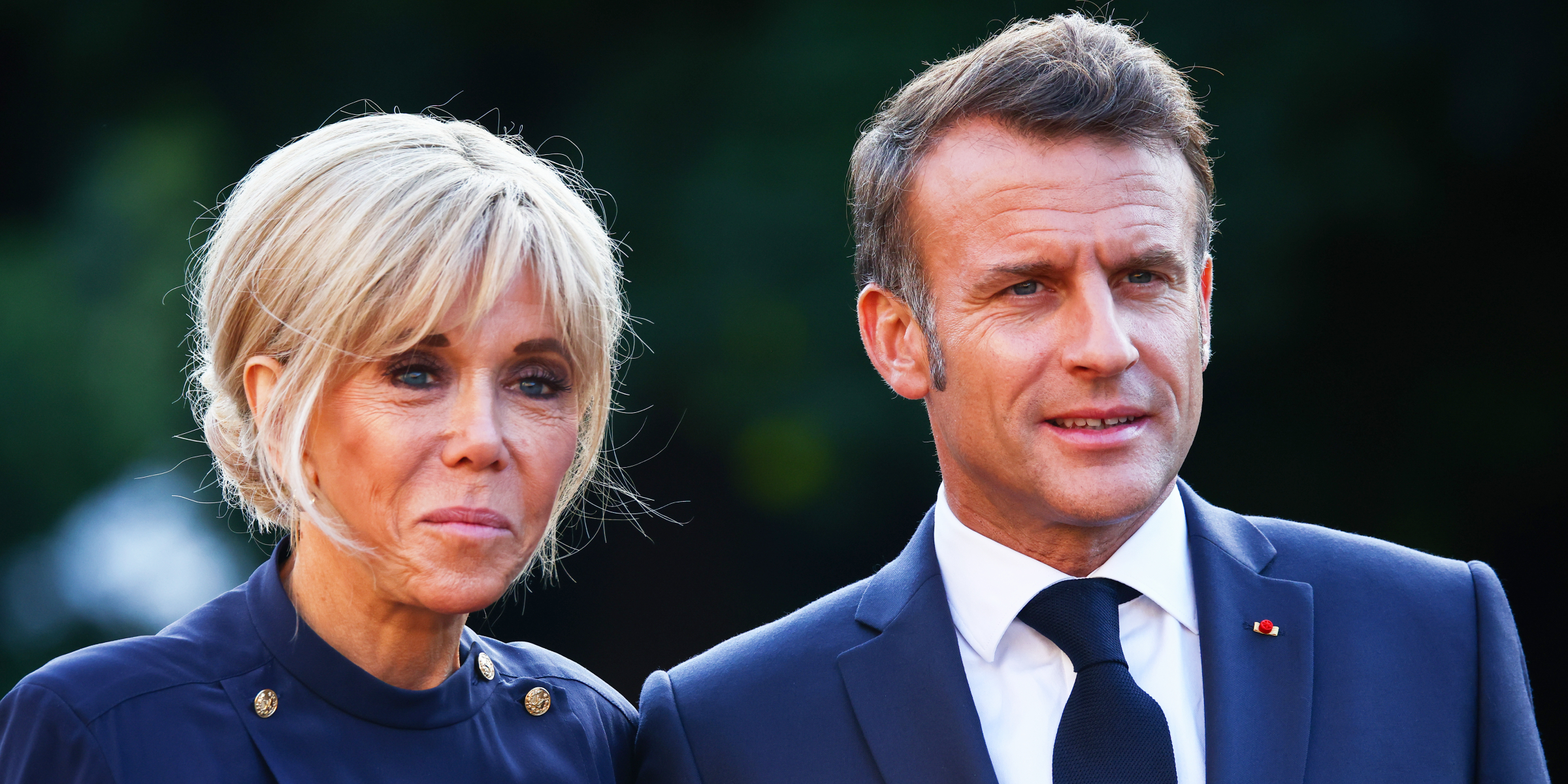
Inside the Residence of French President Emmanuel Macron and Wife Brigitte — Pics and Details
The residence of the French president and his wife, who have recently been the topic of public discourse, boasts large spaces and luxurious architecture.
When French President Emmanuel Macron and his wife, First Lady Brigitte Macron, are not busy jetting off to different countries for state visits, the couple spends time at a grand palace they call home. Their place boasts 11,179 square meters of space (m²), including 300 m² of private apartments, and 1.5 hectares of parkland.
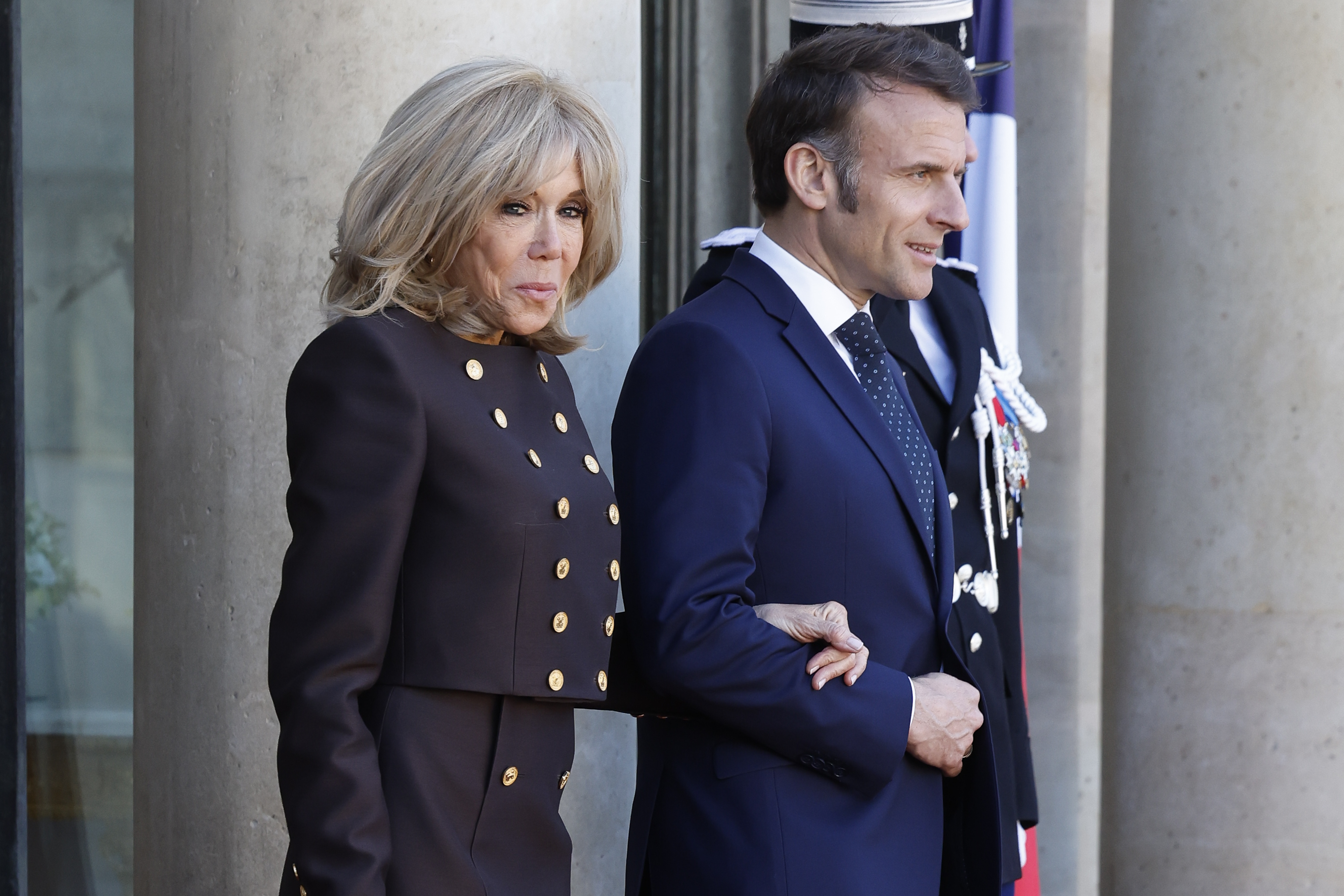
French First Lady Brigitte Macron and French President Emmanuel Macron awaiting to greet the King Frederik X of Denmark and Queen Mary of Denmark outside the Élysée Palace in Paris, France on March 31, 2025. | Source: Getty Images
Beyond its expansive grounds, the French presidential residence is a masterpiece of opulence and history. Inside, the palace includes a staggering 365 rooms and is adorned with 5,000 pieces of Mobilier National furniture, reflecting centuries of French craftsmanship.
Each year, 12,000 flowers are planted throughout the estate, enhancing the already picturesque setting. Intricately designed clocks — 100 in total — and a plethora of curated artworks contribute to the ornate and regal ambiance.
As for the natural surroundings, the estate proudly supports a rich variety of 100 tree species, carefully tended across its manicured landscape.
The home itself, known as the Élysée Palace, carries centuries of legacy. Its origins trace back to the early 18th century when the area of Faubourg Saint-Honoré was little more than rural land. It was here that architect Armand-Claude Mollet, connected to the famed André Le Nôtre, built a townhouse for the Comte d'Évreux.
He positioned the residence strategically between a courtyard and a garden that faced the grand Champs-Élysées. By 1742, the layout would go on to inspire the development of what famous Frenchman Piganiol de la Force dubbed one of Paris's most prestigious neighborhoods (the Faubourg Saint-Honoré district).
Decades later, following the French Revolution and the release of the Duchess of Bourbon, she regained possession of the property in January 1797 and sought creative ways to generate income.
She allowed a tenant named Hovyn to stay on the ground floor, opened parts of the estate to the public, and let the merchant organize social gatherings, such as public dances, in the drawing rooms and garden. Hovyn also opened up the two arcades on both sides of the vestibule door leading to the Great Salon.
During this time, the residence took on the name "Élysée" — a nod to the famed promenade nearby — and the name has endured, a symbol of grandeur and power now synonymous with the French presidency. Let's take a look at several sections of this palace below!
The Façade and Entrance
The grandeur of the Élysée Palace is unmistakable the moment one approaches its iconic façade. Towering with 18th-century symmetry and neoclassical charm, the exterior is a commanding blend of cream-toned limestone, stately columns, and soaring windows that stretch nearly floor-to-ceiling.
The architecture speaks softly of tradition. Above the portico, the national emblem stands proudly, centered beneath the tricolor flag waving atop the roof.
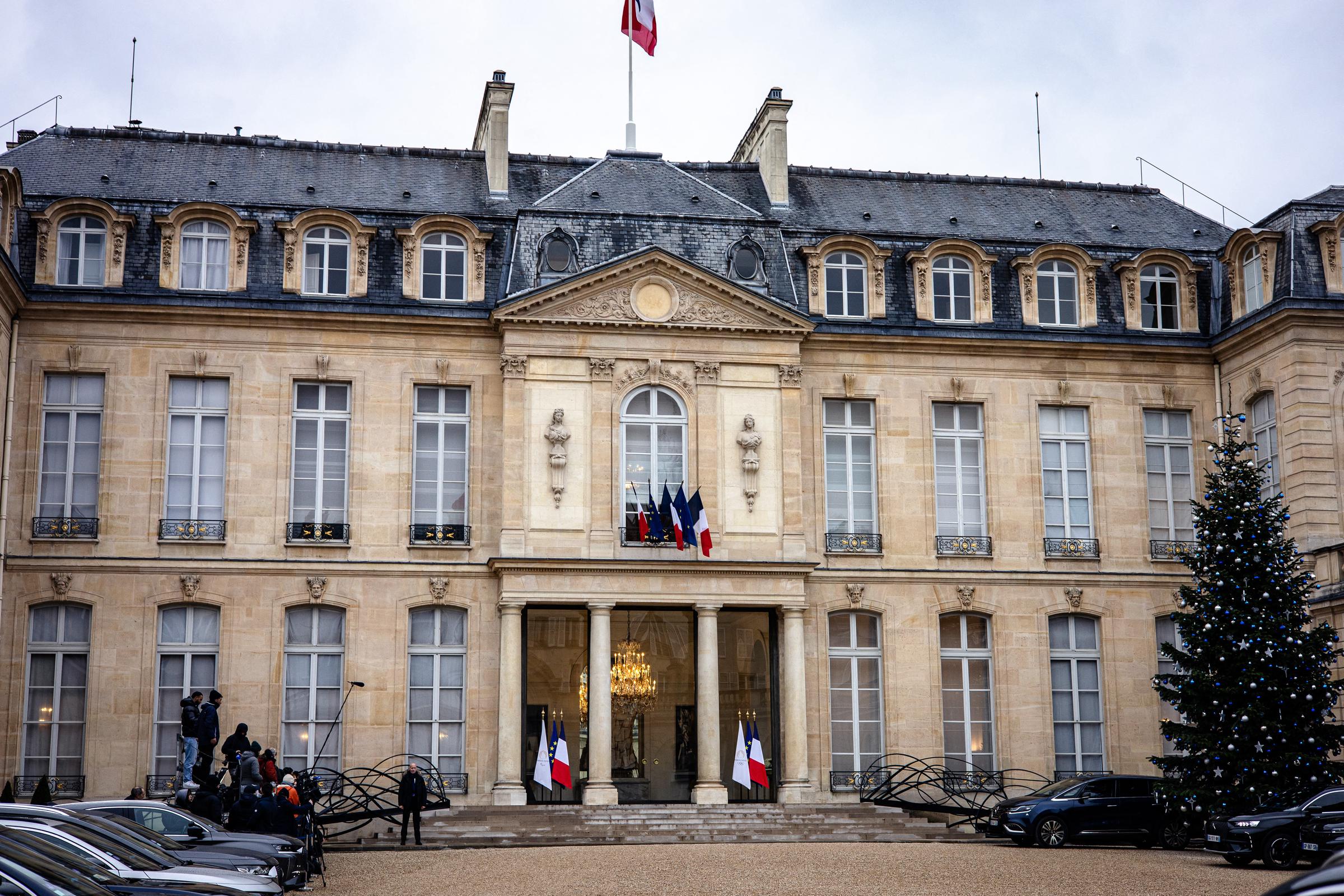
A view of the façade and entrance of the Élysée Palace in Paris, France on December 11, 2024. | Source: Getty Images
As night falls, the rear of the palace reveals an entirely different mood. Illuminated from within, the softly glowing windows cast warm amber light across the garden courtyard. It's here, beyond the stone exterior and crisp formality, that the palace takes on its quieter, more intimate persona.
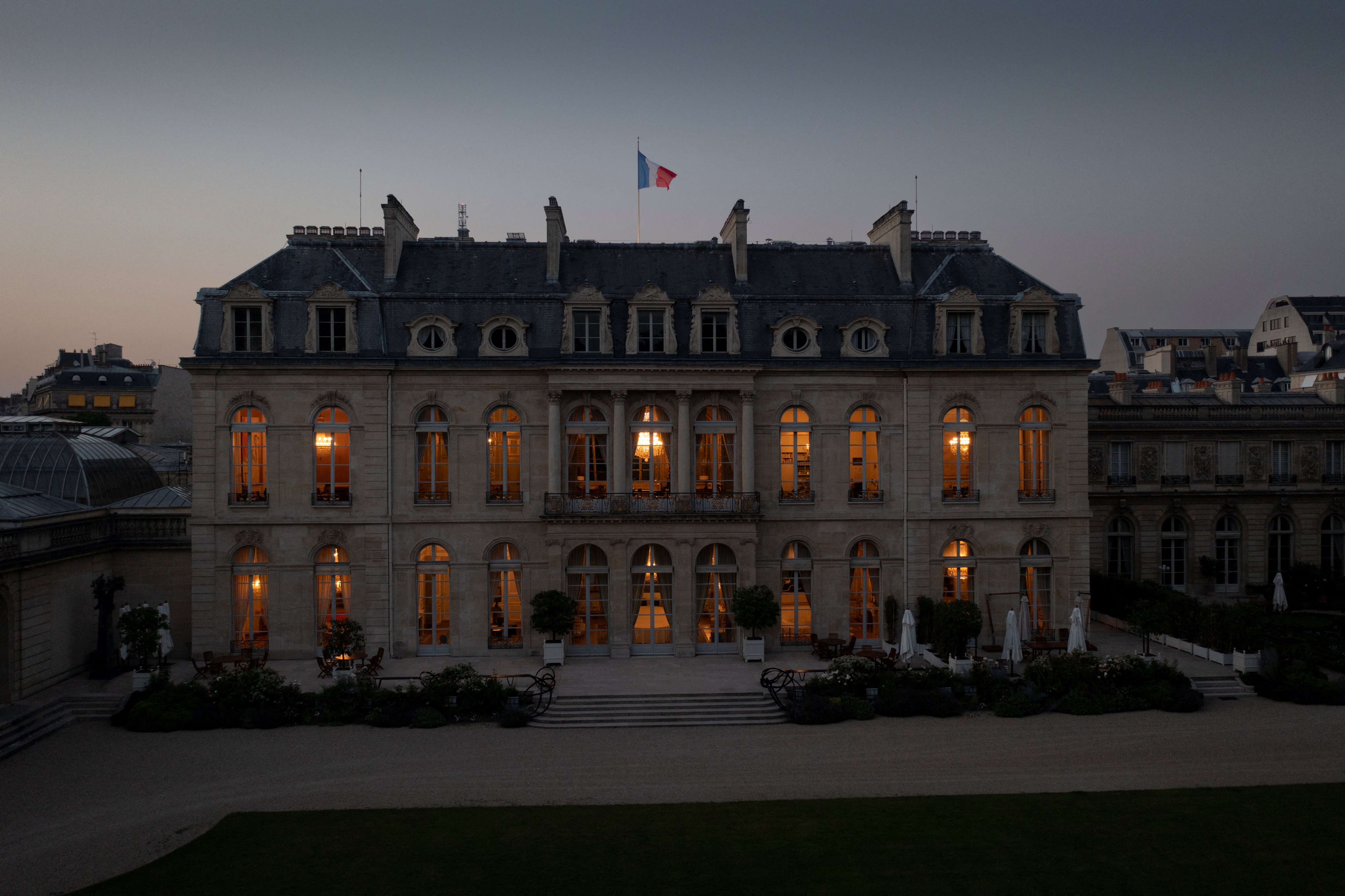
A view of the backside of the Élysée Palace's façade in Paris, France on June 28, 2019. | Source: Getty Images
The Reception Hall
The Reception Hall — also known as La Salle des Fêtes — is where ceremonial splendor meets French artistry. Designed by architect Eugène Debressenne and unveiled during the 1889 Universal Exposition, this space has long been the epicenter of France's most prestigious events, from presidential inaugurations to official receptions and award ceremonies.
The ceiling, enhanced in 1896 with allegorical paintings of Art and Science, surrounds panels titled "The Republic, Guardian of Peace" by Guillaume Dubufe. The opulence continues with six 18th-century Gobelins tapestries adding historical depth to the red-and-gold decor.
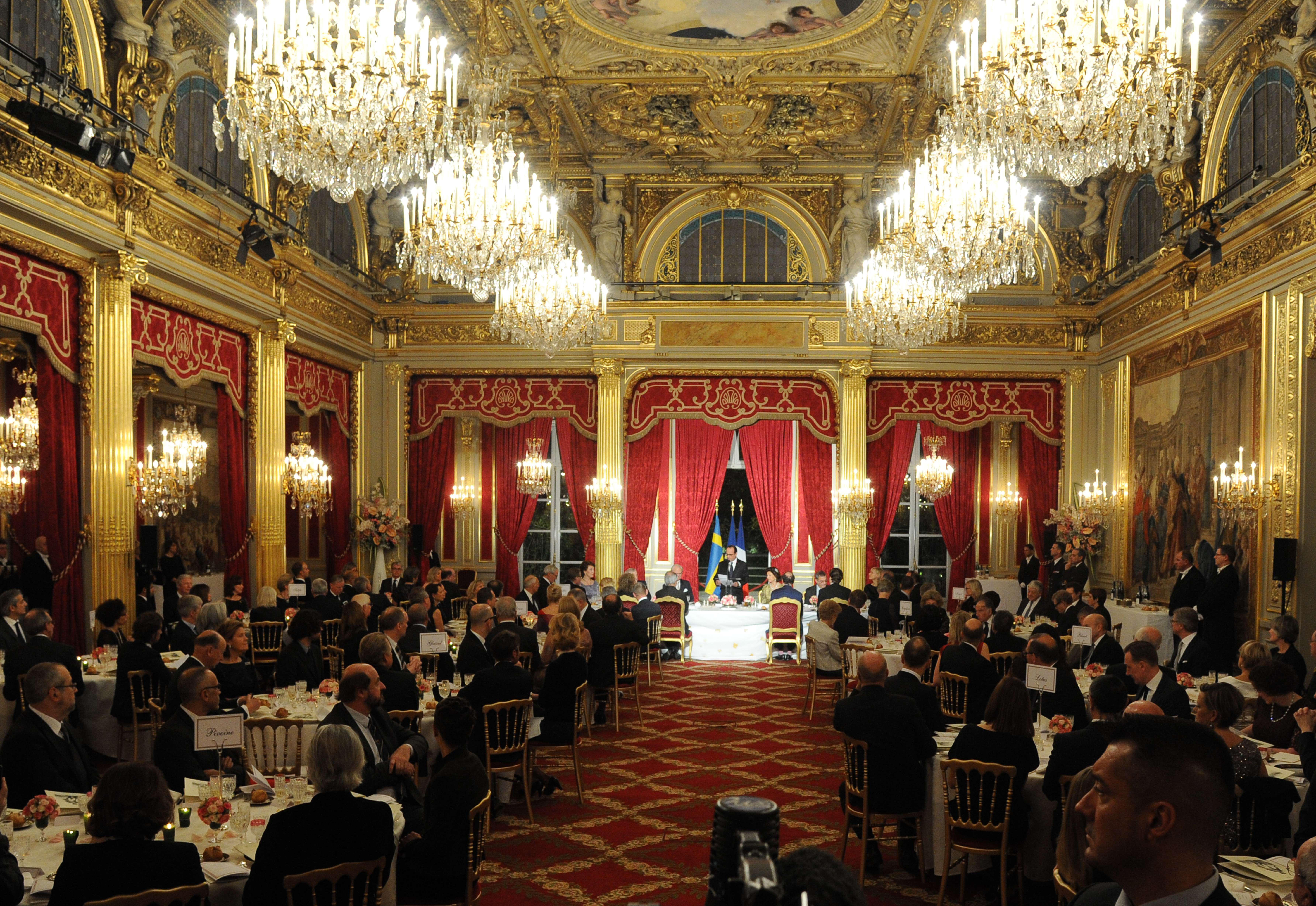
The view from inside the Reception Hall during a diplomatic meeting in Paris, France on December 2, 2014. | Source: Getty Images
Former President François Mitterrand added ten French doors in 1984 to bring more natural light into the space. In photos, the hall glows with the shimmer of crystal chandeliers suspended over plush crimson carpets and rows of golden columns, while velvet drapes frame the room.
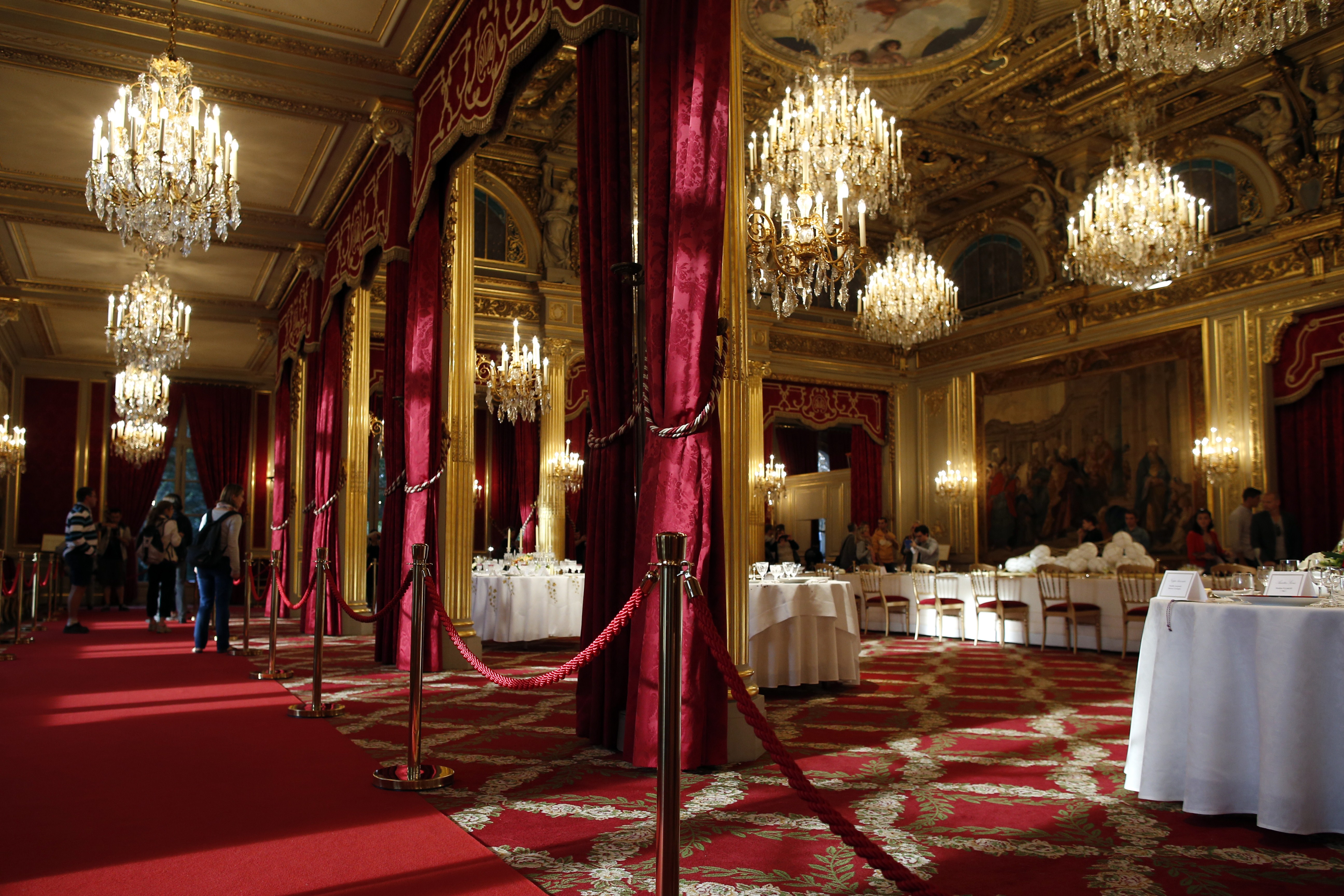
Another angle showing people inside the Reception Hall of the palace in Paris, France on September 20, 2014. | Source: Getty Images
The Winter Garden
Originally constructed in 1881, the Winter Garden once flourished with trellised greenery and tropical plants beneath a sweeping glass canopy. Today, the transparent roof remains, but is paired with orange trees from the Versailles estate.
Inside, three grand chandeliers — dating back to the late 19th century — cast a golden glow over deep red drapes and marble-colored walls. A commanding tapestry from the "Vatican Chamber series," inspired by Raphael and woven in the 1730s, spans the back wall.
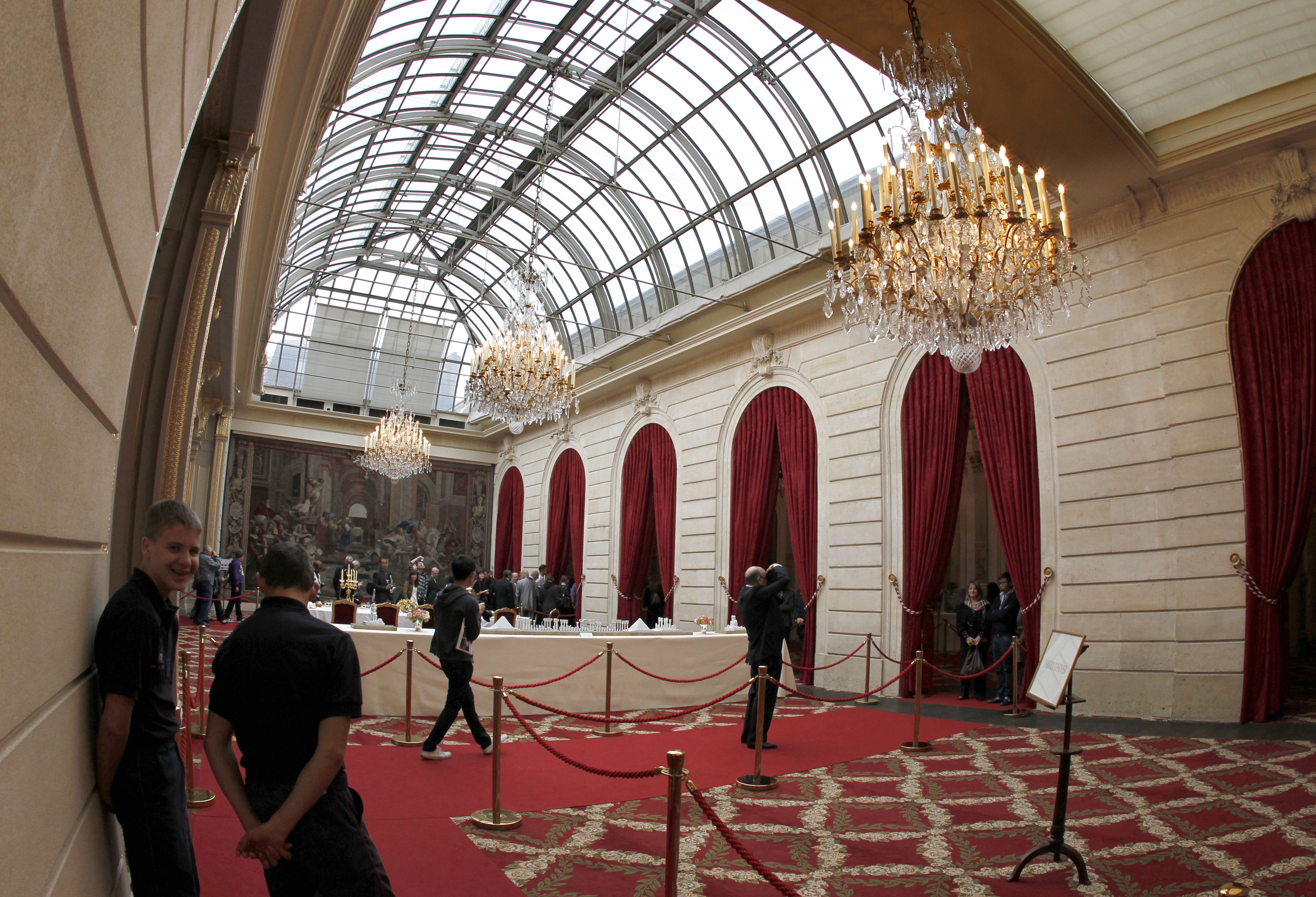
Tourists gathered inside the Winter Garden in Paris, France on September 17, 2011. | Source: Getty Images
Once a lush gallery, the Winter Garden now serves as an extension of the Reception Hall, hosting official functions under the filtered Parisian light.
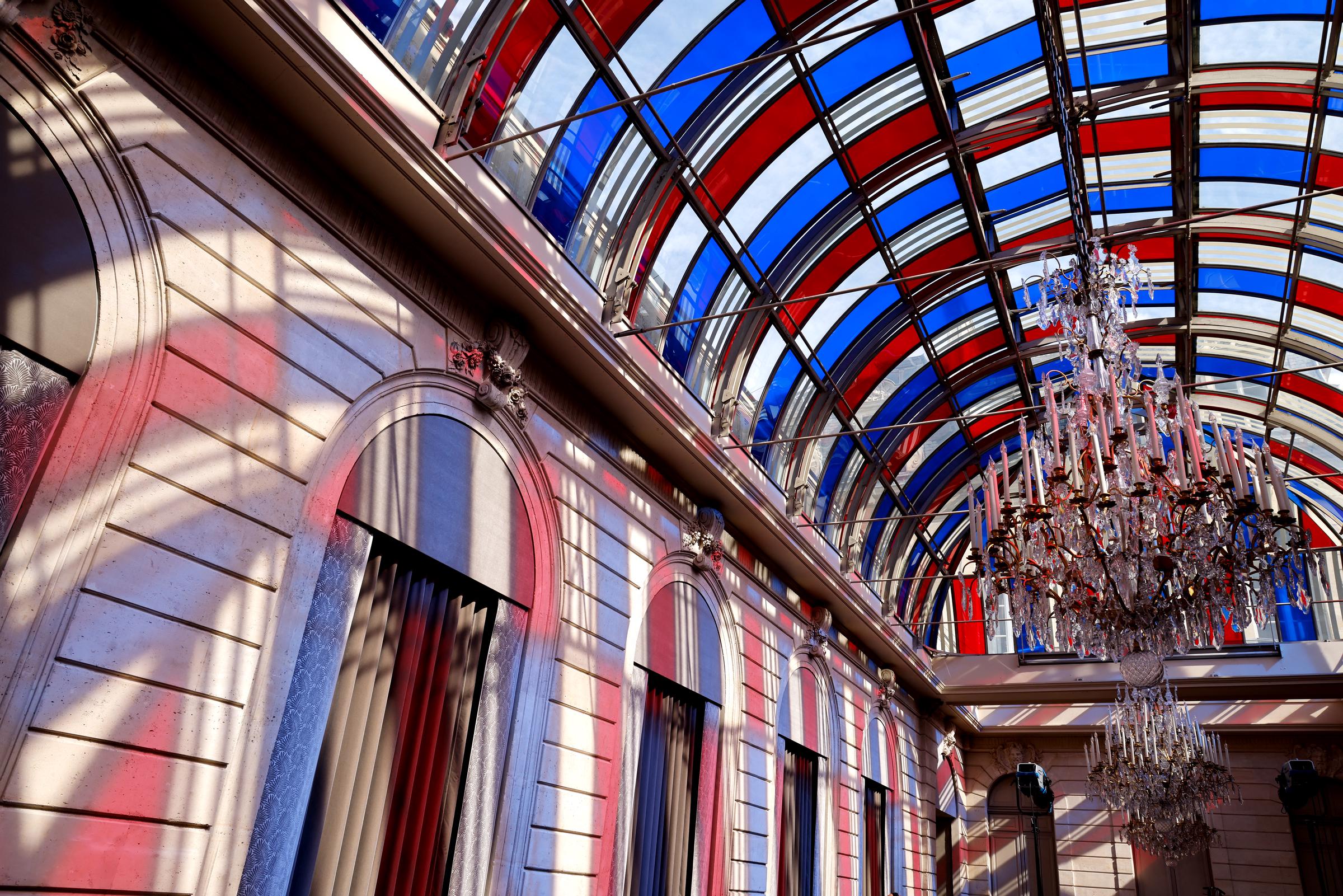
A photo showing the Winter Garden illuminated with a tricolor stained glass window in Paris, France on September 5, 2022. | Source: Getty Images
The Salon Doré
Perched on the first floor of the Élysée Palace, the Salon Doré — or gilded salon — now serves as the President's official office. Once part of the palace's central residential area, the room was transformed into a workspace alongside other nearby quarters, which were assigned to senior staff.
Inside, the space lives up to its name. Walls gleam with intricate gold leaf detailing, framing classical motifs and fluted pilasters.
Sunlight streams through floor-to-ceiling windows, illuminating a lavish desk placed before the French and European Union flags. With crystal chandeliers and finely carved furnishings, the Salon Doré blends political gravitas with the unmistakable elegance of royal-era design.
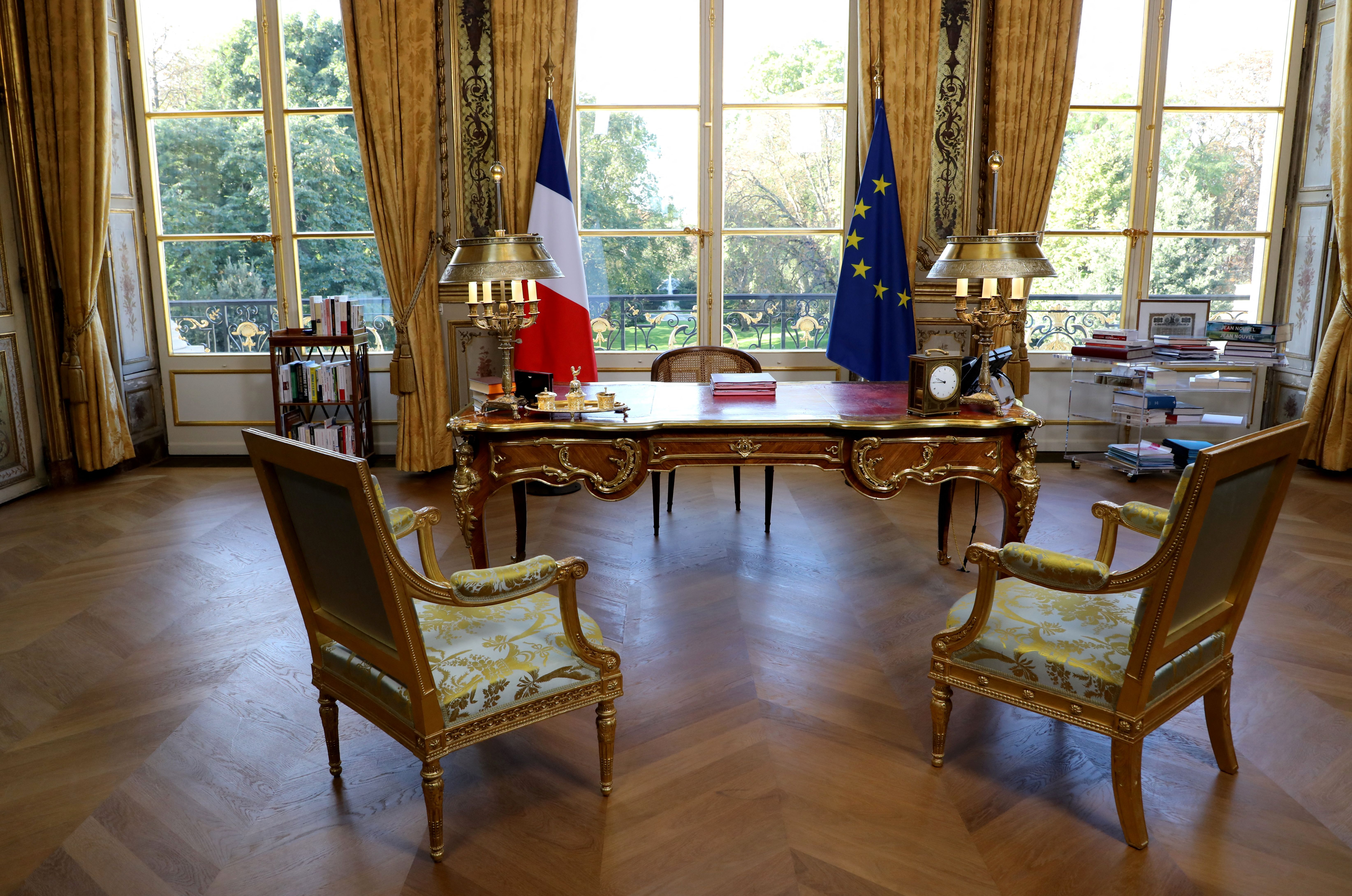
A view of French President Emmanuel Macron's office in Paris, France on September 15, 2017. | Source: Getty Images
The Pompadour Room
Once the reception space of the Marquise de Pompadour — King Louis XV's mistress, who purchased Hôtel d'Évreux with her own funds in 1753 — the Salon Pompadour (Pompadour Room) has long been a room of spectacle and strategy.
Today, the room still hosts conversations of global consequence. Notably, it welcomed European leaders on November 18, 1989, just days after the Berlin Wall fell, as they charted the continent's future post–Cold War.
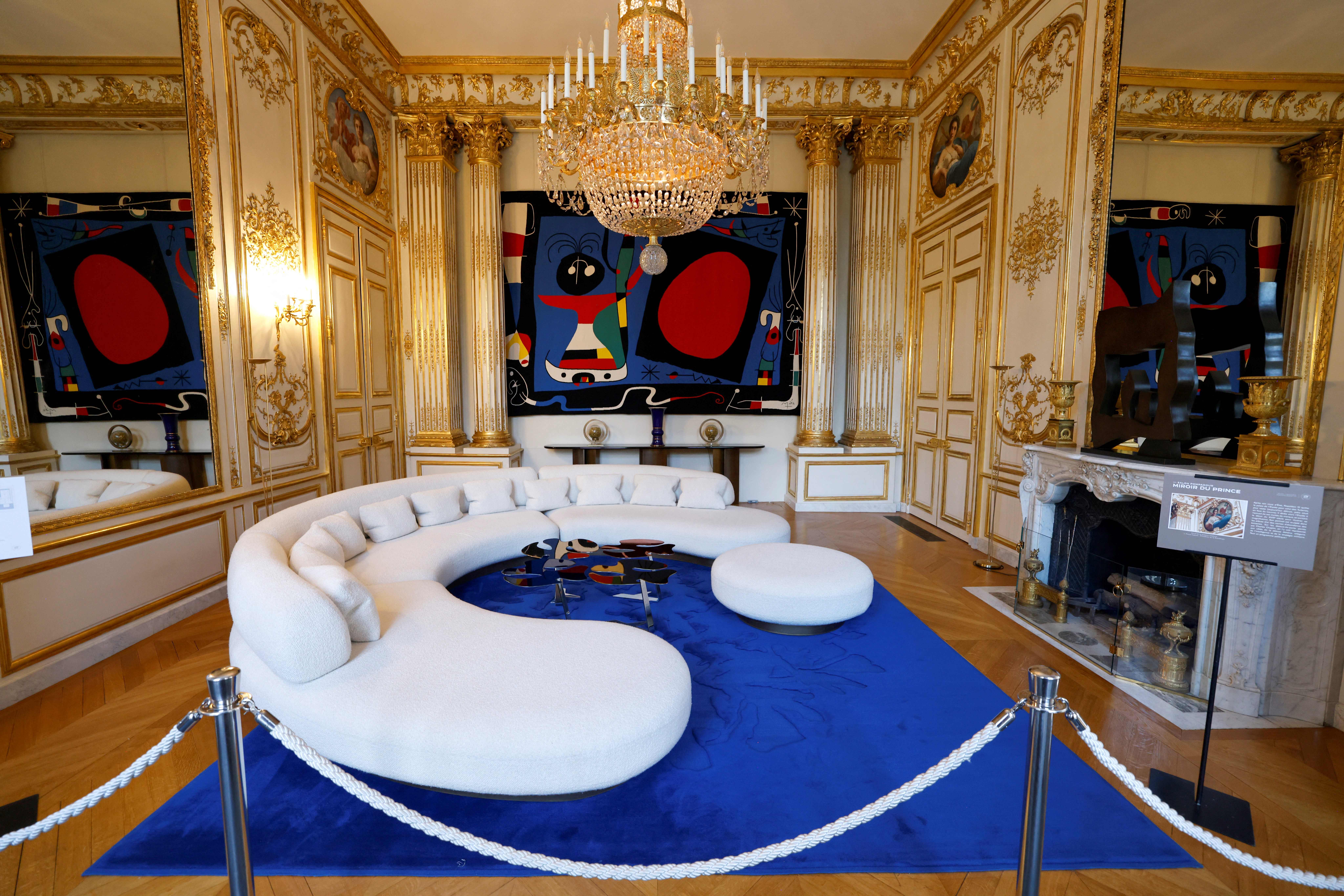
A view of the Pompadour Room in the Élysée Palace in Paris, France on September 16, 2023. | Source: Getty Images
Emmanuel continues to use the salon for high-level meetings and occasional dinners. The woodwork is adorned with Second-Empire overdoors featuring Roman goddesses — Diana, Juno, Minerva, and Venus — each portrayed with classical symbolism.
Against this ornate backdrop, modern art now holds its own: Two Picasso sculptures face off with a vibrant tapestry by Joan Miró.
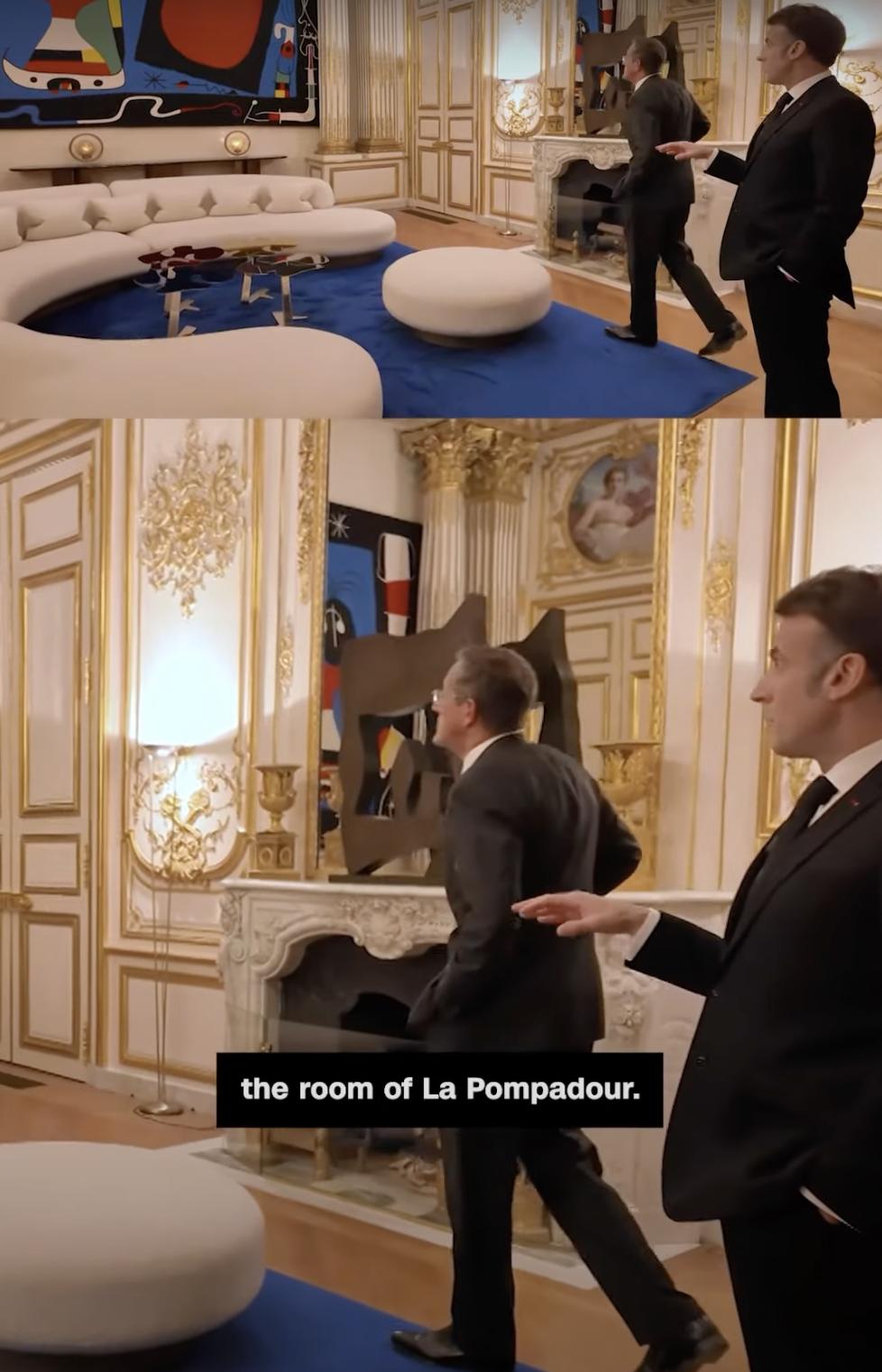
French President Emmanuel Macron showing CNN's Richard Quest around the Pompadour Room, posted on February 12, 2025. | Source: YouTube/CNN
Earlier this year, CNN's Richard Quest was given a rare tour of this room and others by the French president himself, who proudly explained the artworks that now share space with history.
In photos, the room radiates a striking contrast — gold-trimmed panels and a marble fireplace set against a curving white sofa, cobalt blue rug, and bold contemporary art.
The Paulin Dining Room
Once the bedroom of Napoleon III, the Paulin Dining Room is now the last surviving symbol of the modernist wave that swept through the Élysée in 1972 under President Georges Pompidou and his wife. Renamed in honor of designer Pierre Paulin, the room sits in the palace's private wing and is known for its avant-garde aesthetic.
Encased in removable walls made of molded polyester, the room dazzles with a chandelier of 9,000 glass rods and beads hanging beneath a reflective aluminum ceiling.
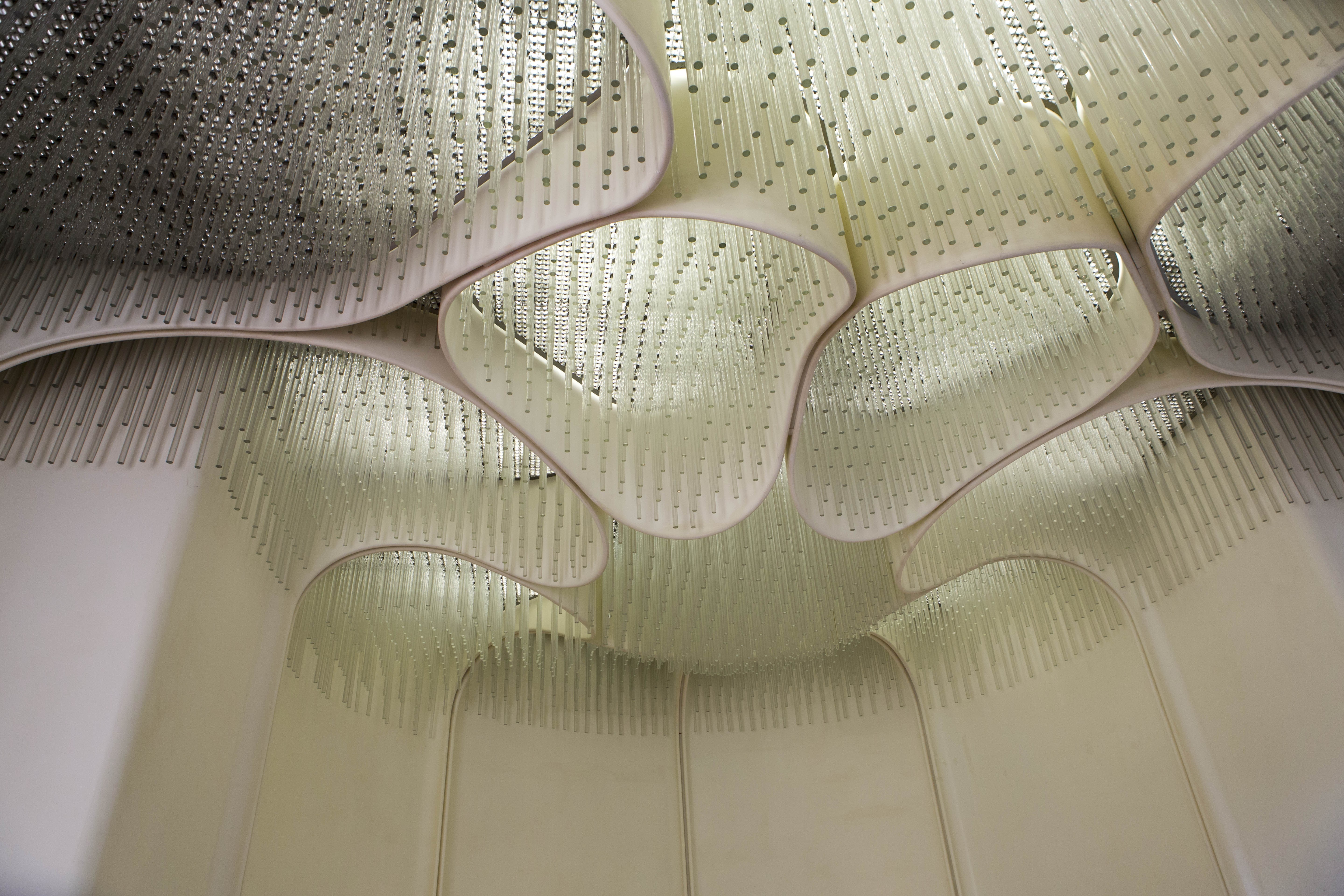
Inside the Paulin Dining Room (Salle à Manger Paulin) in Paris, France on September 19, 2015. | Source: Getty Images
At its heart sits a twelve-seat table with a smoked glass top resting on a cast aluminum base — a design touch that intriguingly echoes the technology used in Apollo spacecraft.
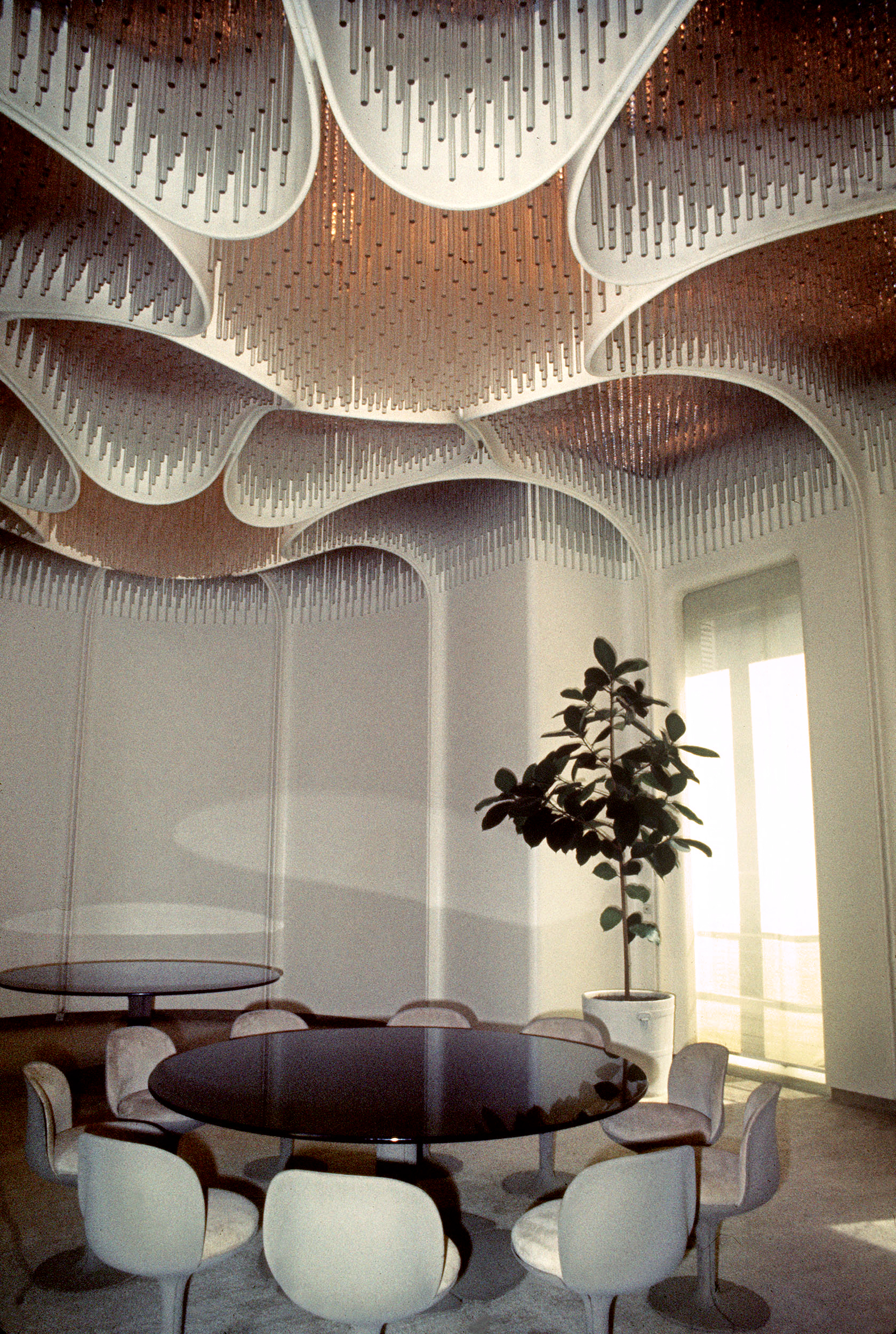
Another angle of the Pauline Dining Room from a photo taken in 1974. | Source: Getty Images
The Fern Room
Known officially as the Salon des Fougères, this refined space has served as the first lady's office since 2007. The room blends historic elegance with sleek contemporary touches. The fern-patterned wall coverings that lend the space its name are replicas of an 18th-century silk design originally created for King Louis XVI's bedroom in Compiègne.
At the center sits a minimalist desk by designer Matali Crasset. Its sleek leather core represents focus and introspection, while its wooden compartments are made to foster creativity, housing everything from files to digital tools.
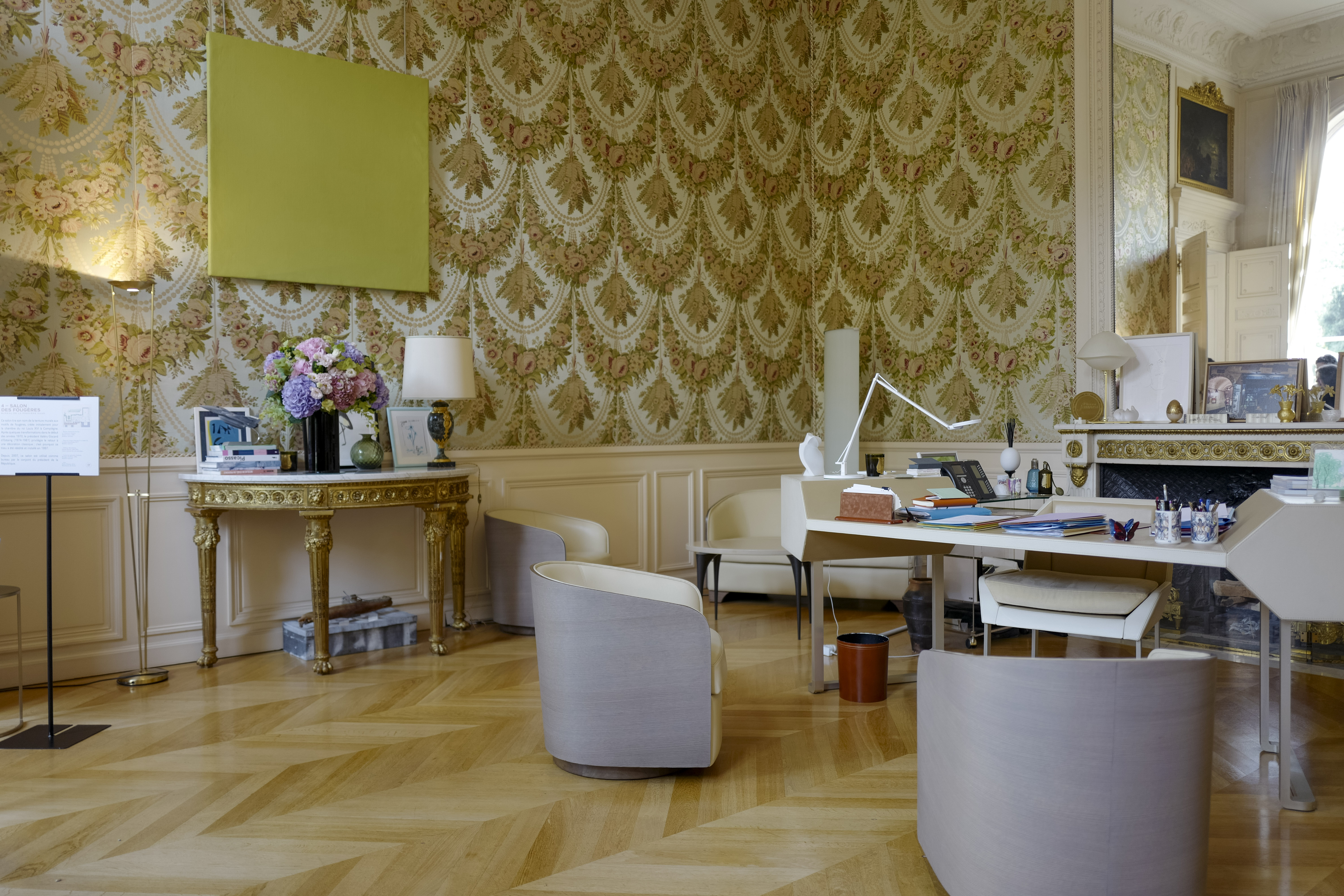
A photo of the Fern Room in Paris, France on September 21, 2024. | Source: Getty Images
The Silver Boudoir
Tucked within the East Wing — the president's private residential quarters — the Boudoir d'Argent, or Silver Boudoir, is a place where both French history and intrigue have left their mark. Created in 1807 and later redesigned by Caroline Murat in 1813, this intimate space was ahead of its time with its silver-toned woodwork, mauve hues, and delicate white gold gilding.
Though modest in size, the room's legacy is anything but. It was here that Emperor Napoleon I signed his abdication after the crushing defeat at Waterloo in 1815.
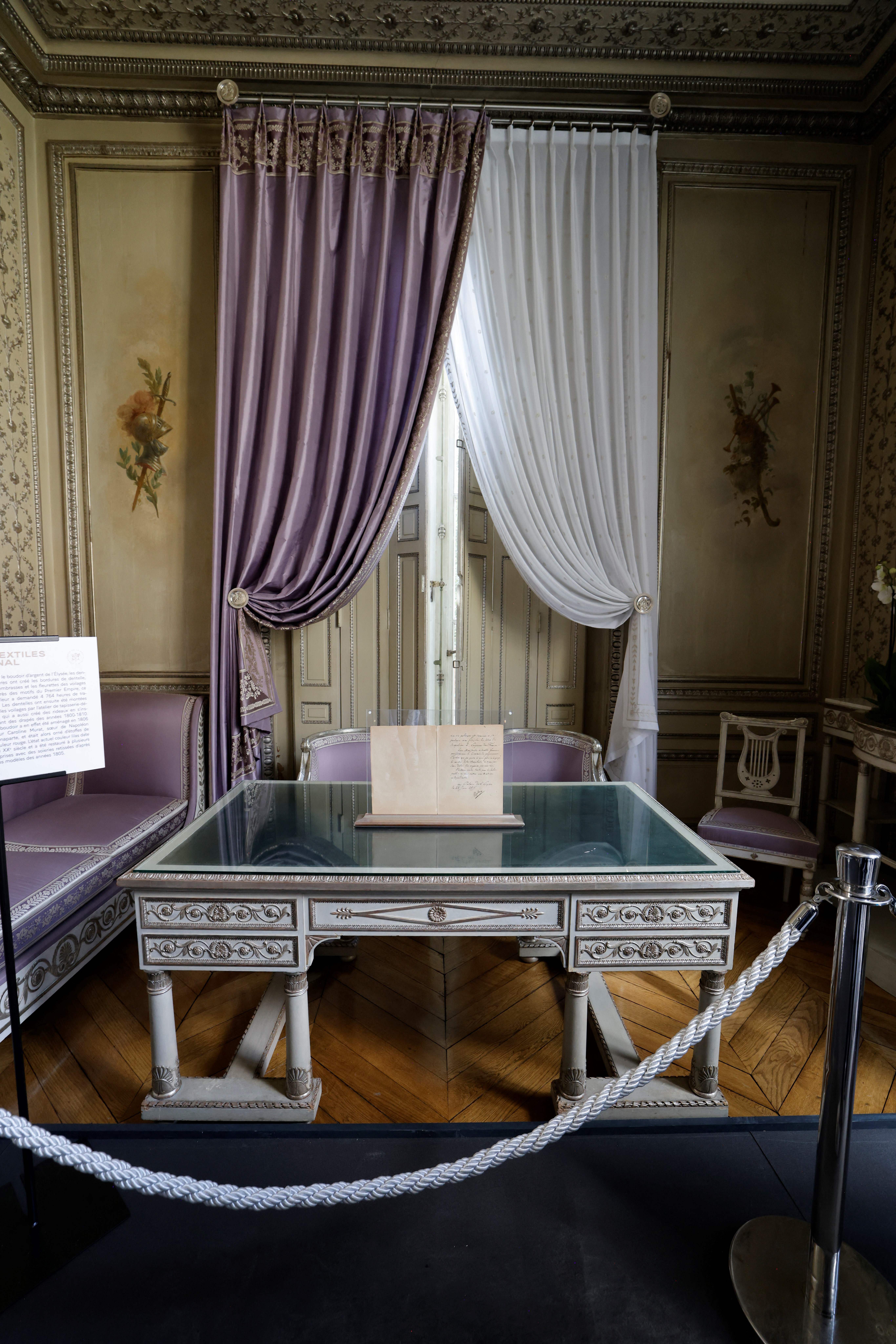
Inside the Silver Boudoir in Paris, France on September 17, 2022. | Source: Getty Images
In the years that followed, President Louis-Napoléon Bonaparte plotted his 1851 coup d'État in the same space. Then, in 1899, President Félix Faure suffered a fatal seizure during a secret tryst with his mistress, Marguerite Steinheil.
Now part of the reception apartments, the Silver Boudoir remains preserved not only for its artistic detailing — lyre chairs, swan-emblazoned armchairs, and 18th-century paneling — but for the echoes of pivotal moments that once unfolded within its walls.
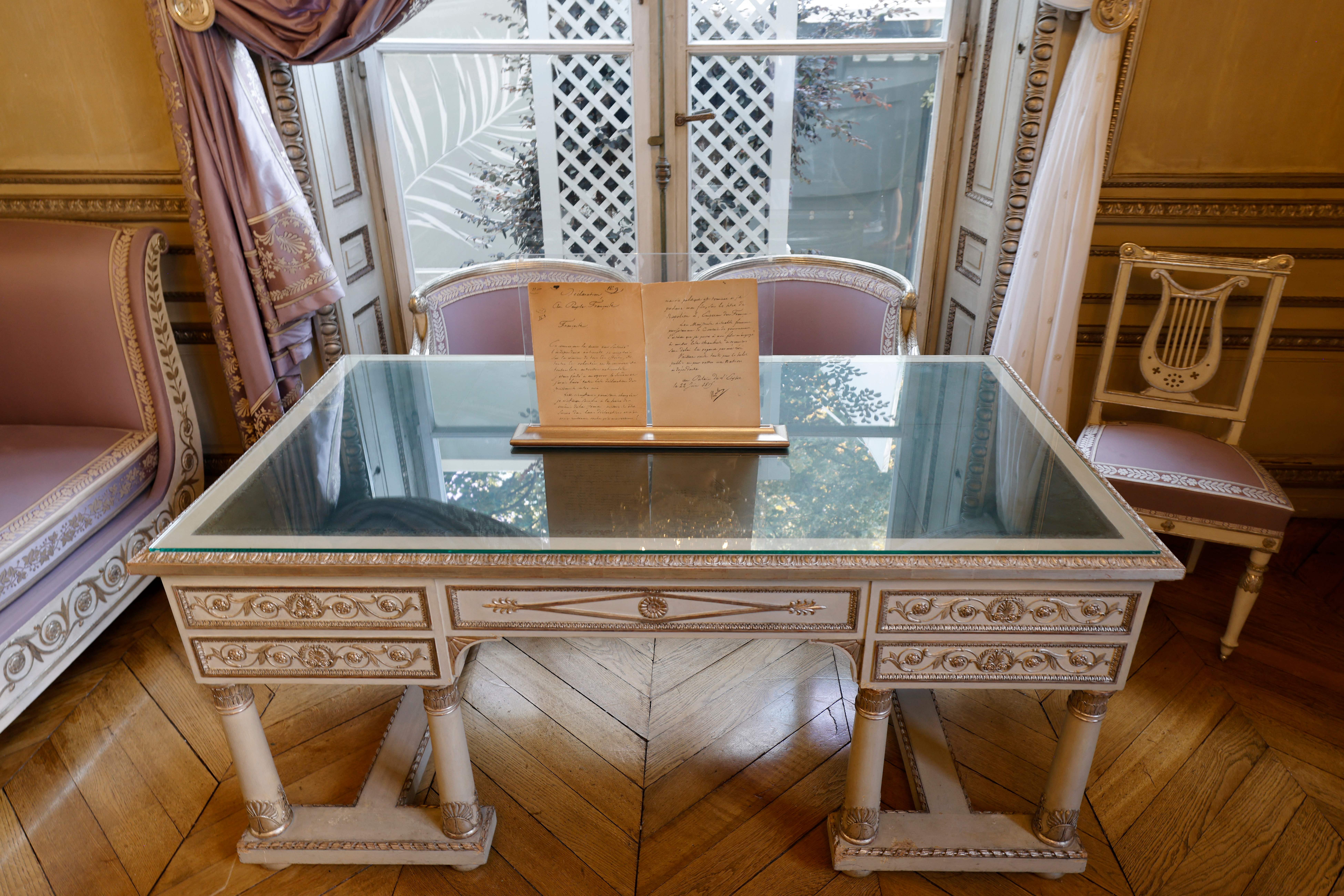
A desk and chairs in the Silver Boudoir in Paris, France on September 16, 2023. | Source: Getty Images
Beyond the opulence of France's first couple's shared residence lies a partnership built on deep emotional closeness. In a 2017 interview with Elle, Brigitte revealed that she and Emmanuel do not enjoy spending nights apart at all, which is rooted in the comfort and connection they find in each other.
Describing their relationship as natural and "fluid," she noted that despite their age gap, their bond felt inevitable, like two puzzle pieces that simply belonged together.
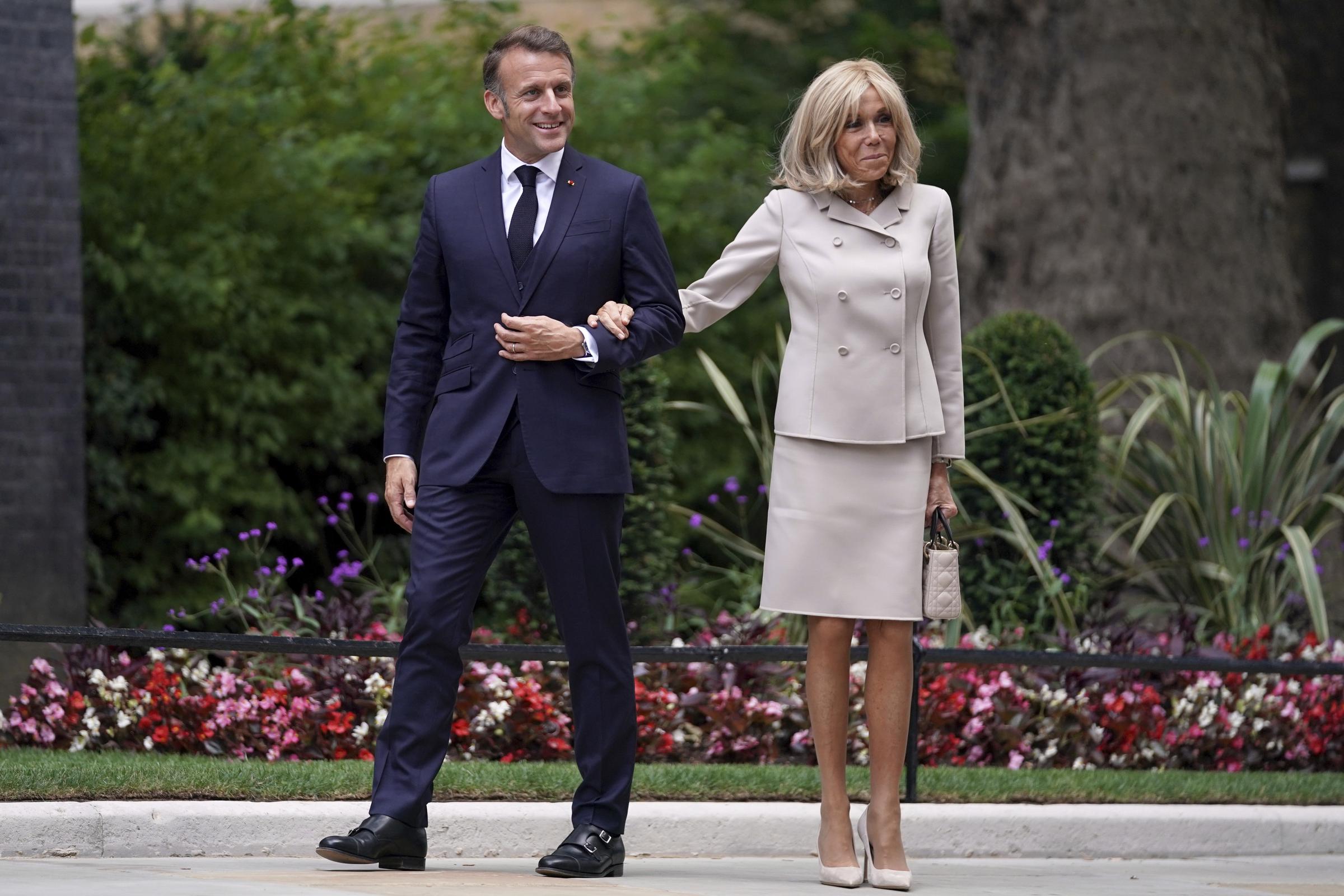
French President Emmanuel Macron with French First Lady Brigitte Macron during day 2 of their state visit to the UK on July 9, 2025. | Source: Getty Images
While Brigitte's interview remarks and the aforementioned details about the Élysée Palace offer a look into their private world, it was a recent public moment — far from gilded halls and historic rooms — that stirred fresh debate about the Macrons' relationship.

Netizen comment about French First Lady Brigitte Macron and French President Emmanuel Macron, posted on July 9, 2025. | Source: Facebook/DailyMail
In a now-viral clip, shared widely across social media, Brigitte seemingly ignored Emmanuel's attempt to offer his hand as they arrived in Britain on Tuesday, July 8, 2025, for a three-day state visit.
As they disembarked the aircraft, Emmanuel reached toward his wife, but Brigitte, holding onto her clutch and one of the railings, did not acknowledge the gesture.

The 'embarrassing' moment between Brigitte and Emmanuel Macron as she descended the aircraft stairs in Britain, posted on July 8, 2025. | Source: Facebook/Daily Mail
Although Emmanuel tried to shake off the moment by smiling and shaking hands with people gathered by the plane, his expression was noticeably subdued.
Meanwhile, Brigitte stood a few steps behind after she descended the aircraft stairs. The seemingly awkward exchange prompted online speculation about potential tension between the couple.

Brigitte Macron descending the aircraft stairs as she and her husband Emmanuel Macron arrive in the UK. | Source: Getty Images
Social media reactions came swiftly, with the moment being dissected across platforms. One netizen wrote, "Ouch!!! That hurt😂😂😂 She keeps embarrassing this man every opportunity she gets!"
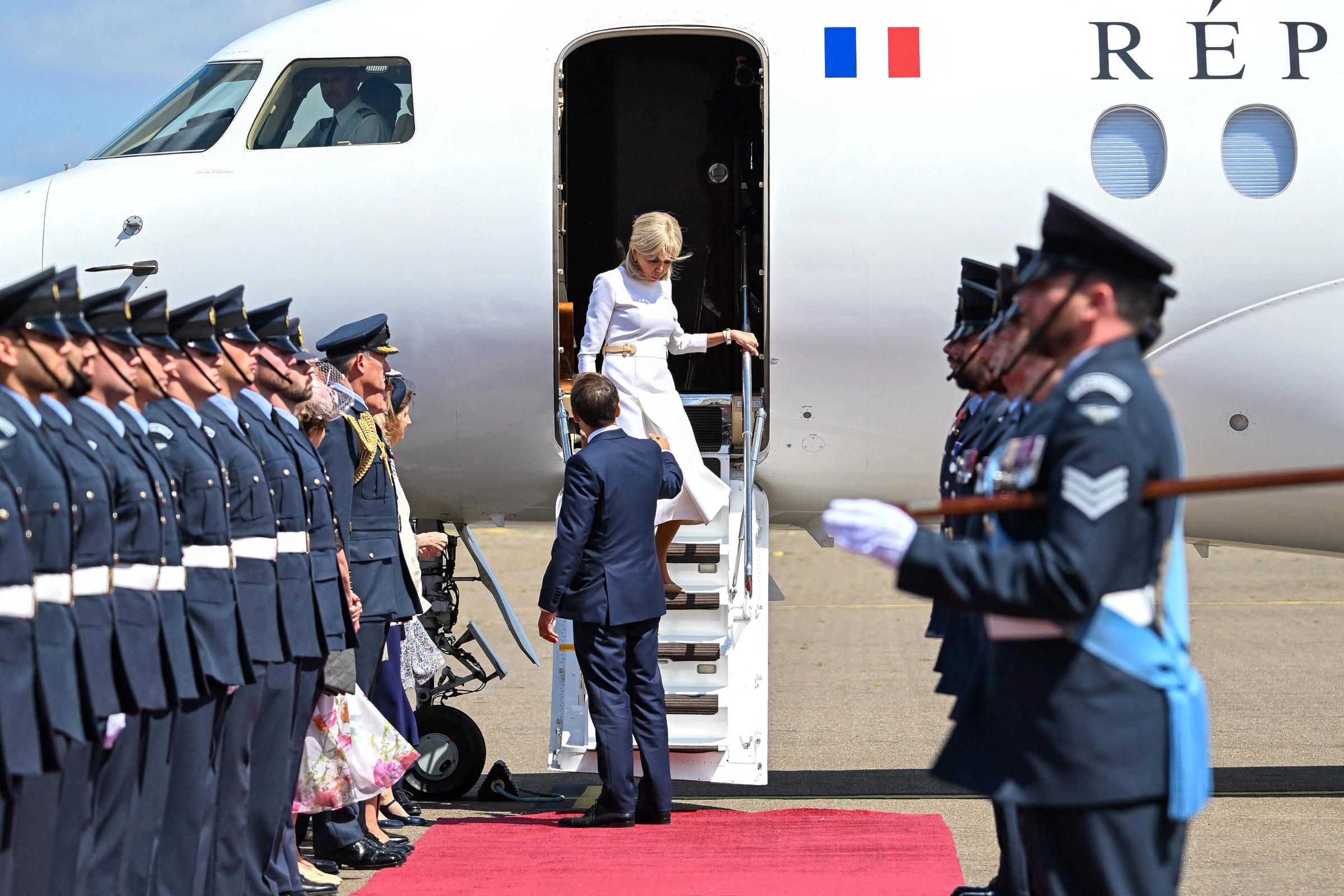
Emmanuel Macron extends his hand to his wife, Brigitte Macron, as she descends the aircraft steps. | Source: Getty Images
Another echoed the sentiment with, "She is awful to do this on [sic] public!!" while someone else wondered, "They're fighting again?"
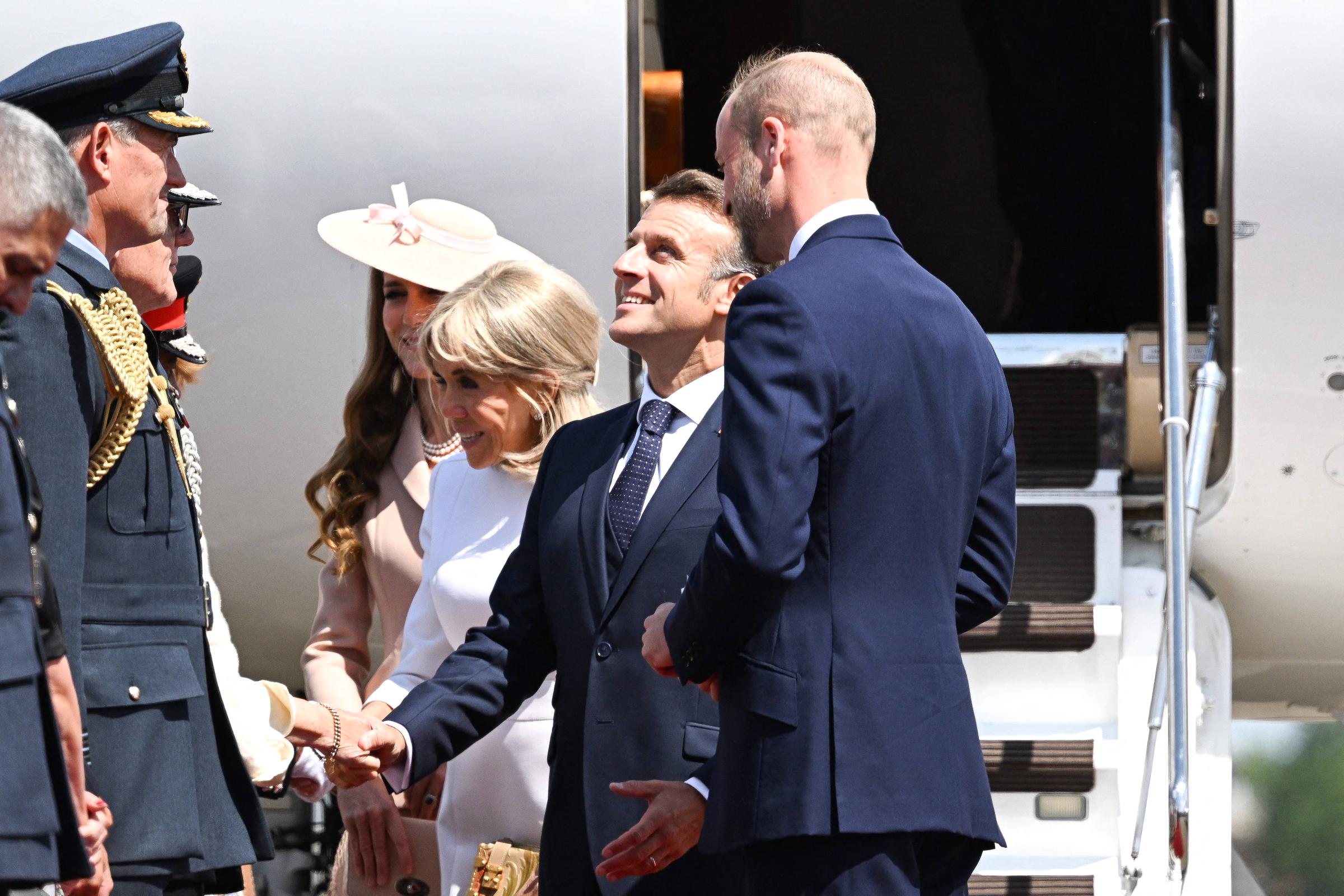
Emmanuel and Brigitte Macron greet the welcoming party, including Prince William and Princess Catherine, as they arrive in Britain for their three-day visit. | Source: Getty Images
Yet another comment read, "Very rude lady 😒." Meanwhile, a fellow observer expressed, "Again???????" On the flip side, others urged for understanding, with one person stating, "Y'all act like married people can't have problems."
Some viewers even challenged the narrative altogether, dismissing claims of a snub. A spectator noted, "I don't see the snub. She smiled at him." Another defended Emmanuel's resilience, "Whatever people say he is still a good powerful man who put a lot of patience into their relationship [sic]."
